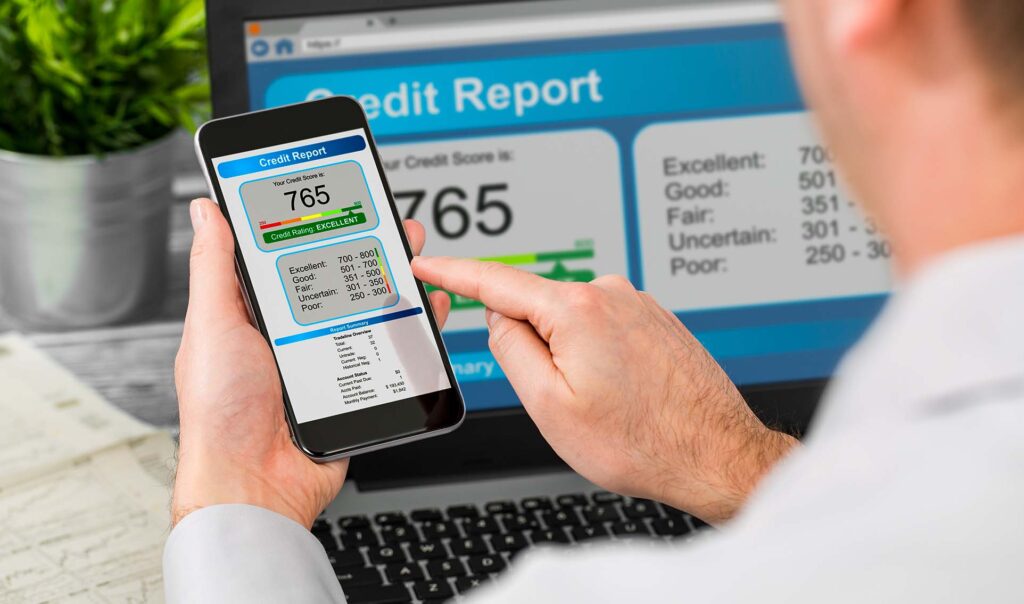A consumer’s financial health is a significant concept to tackle, with many affecting factors and improvement strategies based on individual needs. Determining a person’s financial standing also depends on different contributing perspectives. Consumers are likely to focus on cash flow, savings goals and reducing their expenses. However, a bank that is looking to lend a consumer money will look at much different information to assess a person’s financial fitness, such as debt-to-income ratio, derogatory marks and credit score.
Given the influence these factors have on a consumer’s ability to access credit at reasonable rates, consumers must be educated about their finances. This goes beyond knowing basic monetary concepts and information and gets to the heart of what is most helpful to consumers: understanding how their financial data affects their financial health and how to improve it.
Personal Finance Education Stagnation
Unfortunately, basic and practical financial wellness concepts are not consistently taught to many consumers. In fact, public education requirements for personal finance curriculums or classes vary from state to state or even by school district. Because of this, many consumers have never had any formal introduction to the information that governs the rest of their financial lives. Thus, many have had to seek out this information independently or learn from experience.
On the upside, consumers report the highest financial well-being rate since 2013. While this trend is positive, the data still shows there is much work to be done to improve Americans’ financial picture.
So, where does this leave consumers? While the question of who should be responsible for educating consumers is still a debate, we know that banks have the unique opportunity to step in and provide the resources to improve people’s financial well-being. Providing this education protects consumers from predatory lending and helps them build confidence in their finances. Partnering with customers to deliver personal finance education also helps garner brand loyalty and promote your bank as the positive community organization it is.
After all, trusted institutions are in high demand. Consumers seek institutions that can meet their banking and lending needs and serve as a financial partner to build a relationship with as they grow, from opening their first credit card to their first mortgage to their children’s college savings accounts and beyond. A crucial part of fulfilling this financial partnership with consumers involves the ability to surface their financial data in an accessible, easy-to-understand way and provide valuable insight. One way to do this is through the digital banking experience.
Watch our on-demand demo to learn how offering credit score monitoring within your digital banking experience can deepen customer engagement.
Consumer Access to Credit Scores and Reports
The most common questions consumers have about their financial picture relate to their credit scores and reports. The Fair Credit Reporting Act, enacted in 1970, entitles consumers to one free credit report from each credit bureau. The free credit report provides consumers with the means to check for fraudulent activity and report any disputes. It also gives them insight into what creditors see when they pull their credit. However, this does not necessarily guarantee a free credit score.
Noticing the gap in access to credit scores and calculating factors, third-party credit monitoring services entered the picture and set out to close it. And while these services are a good resource for consumers to access credit information frequently, these third parties also provide the same credit data that consumers access to their sponsors, such as the top 20 banks, neo-banks and private equity firms. Data extracted from credit monitoring services is then used for advertising competing products and monetizing the service to those users. For example, Credit Karma – a popular personal finance company – utilizes credit information to surface their investors’ credit offers. It also gives an “approval odds” estimate, nudging the consumer to apply if they’re likely to be extended the credit.
The Demand for Personal Financial Management
The days of balancing checkbooks are in the past for many, but how does this newer generation track their finances? Some rely on cash budgeting (like the envelope method), others use spreadsheets and some keep an eye on their balance and mentally track what they can. Others use technology, such as personal finance software, which is often free and shows a breakdown of how they’re spending money.
According to a Chase Digital Banking Attitudes study, 17.5% of millennials use mobile banking apps for budgeting. Mint – a popular third-party personal budgeting app – proved the demand for money-tracking solutions when it gained 1.5 million users in just two years of launching the service in 2007. Beyond Mint, there is a growing field of other players utilizing popular budgeting techniques and bringing them to the digital space in combination with other financial tools like bill tracking, net worth calculations and more. Once one of these tools has been adopted by a consumer, they are unlikely to use another solution.
These budgeting providers are attempting to create a centralized place for financial data and tools, aggregating data from customers’ financial institutions and bringing all the information to them using one login. This financial hub concept appeals to consumers for many reasons, including ease of use, automation and accessibility.
Determining Your Bank’s Approach to Credit Monitoring and Personal Financial Management
There are many benefits to promoting financial health and offering services that help consumers budget and review their credit score, report and alerts. Here are a few ways your institution can bring some or all of these services to your digital banking strategy and position yourself at the center of your customers’ financial wellness journey.
 Personal finance management tools can easily be integrated into your customers’ digital banking experience, making your bank a financial hub by delivering all their information in a central location.
Personal finance management tools can easily be integrated into your customers’ digital banking experience, making your bank a financial hub by delivering all their information in a central location.
Implement Integrated Financial Tools
Personal finance management tools can easily be integrated into your customers’ digital banking experience, making your bank a financial hub by delivering all their information in a central location. As we continue to see banks build these services in their digital platform, we see growth in what a bank offers in a financial relationship beyond just a depository and lending institution to consumers. Instead, they become a trusted resource for financial tools, insight and planning.
One of the many benefits of this technology is the ability to help consumers grow their savings, showing them where they spend their money and allowing them to build a plan to start paying themselves first.
Data shows that only 68% of adults can cover an unexpected expense of $400 with cash or an equivalent. While this number continues to trend up in recent years, there is still a large gap of people who don’t have the means to pay for an emergency. Given that 20% of adults had an unexpected medical expense (median cost between $1,000 and $1,900), and 16% of people went through financial difficulties due to a natural disaster, that’s a concerning figure.
While a lack of savings or an emergency fund is not always a matter of not having a budget, budgeting tools help consumers figure out where their money goes and where they may even be able to reduce expenses. Such insight is necessary to minimize the expenses that affect their ability to save.
Engage with Customers and Offer Financial Education Resources
Other than tools that enable consumers to view and interact with their financial data, your bank can utilize the digital experience to promote financial literacy and instill more valuable information or reach new and existing customers.
Digital banking is more than a means for consumers to access their finances; it’s a critical touchpoint for banks to reach customers and communicate information to them online. This can be done via secure messaging to provide the excellent service seen in branches or even broadly communicating to all end users through targeted ads and offers.
Are you focused on financial wellness and hosting seminars at your bank? Do you have important resources to share? Do you have financial tips that you want to focus on every month? Use digital communication systems, like secure messaging, chat, targeted marketing and custom text areas. Your bank’s digital presence should also continue beyond digital banking by leveraging effective communication on your website and social media channels.
Partner with a Credit Monitoring Service
Through a fully integrated, all-in-one credit monitoring program, consumers can learn what their credit score is, what influences this number, where they can improve, how specific actions will affect their score and receive alerts for any new activity. It can also provide your bank with valuable information regarding customers’ creditworthiness—thereby lowering your chance of risk and write-offs. Overall, this service makes your institution’s digital banking a financial hub rather than a simple access point for your customers to view their accounts.
One of the most valuable tools of a credit monitoring service is a score simulator, allowing your customers to play out specific scenarios and see how they may affect their credit. These scenarios may include a new auto loan, closing a credit card, removal of a derogatory mark and more. This simulator also goes beyond immediate effects, showing how the action may affect their score later. A credit simulator tool gives consumers confidence in their activities and provides hands-on information to educate them about what actions influence credit scores.
Besides creating a financial hub that can provide credit scores and insight to consumers, offering credit monitoring services also brings credit data to your bank and allows you to provide valuable financial suggestions to a targeted audience who may benefit from your products. Offers could include refinancing to those with outside loans, consolidation for anyone with high credit card debt or an intro rate offer on a credit card at your bank.
 Offering credit monitoring services also brings credit data to your bank and allows you to provide valuable financial suggestions to a targeted audience.
Offering credit monitoring services also brings credit data to your bank and allows you to provide valuable financial suggestions to a targeted audience.
Understanding that Financial Wellness is an Opportunity
As complex as financial wellness may seem, it’s ultimately an opportunity for your bank to build relationships. Your bank is more than a financial institution – it’s a community organization invested in the lives and success of your customers. While your customers know this, it can be easy to feel distanced in the digital space, but this doesn’t have to be the case.
By incorporating your bank’s level of service into your digital banking experience through financial wellness efforts, it grows beyond a ledger of accounts and makes your digital banking an extension of your in-branch experience. When your customers need financial planning insight, have questions about their financial health or want help understanding how they can better save money, it’s important to create an opportunity for them to turn to their trusted bank. But as we know, people are looking for digital touchpoints and convenience. Luckily, there are options to meet them there.
Developing a digital strategy ahead of time to encourage financial wellness and putting the customer first will set you ahead of the competition. Check out our on-demand demo to discover more ways to drive engagement and remain at the center of your customers’ financial health journey.
WATCH THE DEMO